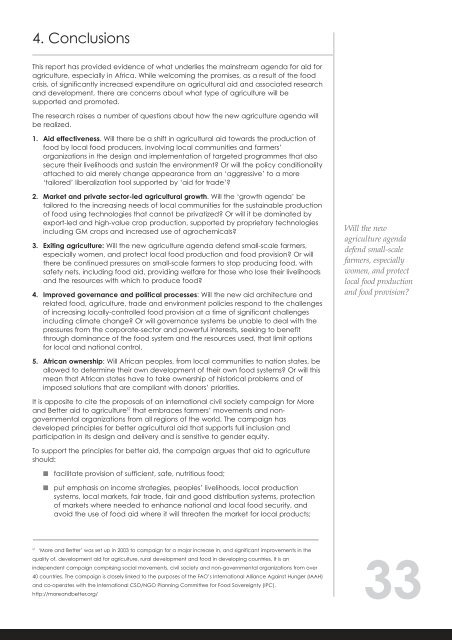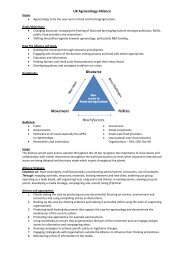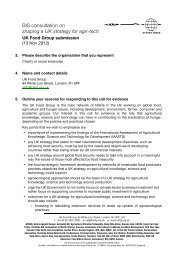More Aid for African Agriculture: policy options for ... - UK Food Group
More Aid for African Agriculture: policy options for ... - UK Food Group
More Aid for African Agriculture: policy options for ... - UK Food Group
You also want an ePaper? Increase the reach of your titles
YUMPU automatically turns print PDFs into web optimized ePapers that Google loves.
4. Conclusions<br />
This report has provided evidence of what underlies the mainstream agenda <strong>for</strong> aid <strong>for</strong><br />
agriculture, especially in Africa. While welcoming the promises, as a result of the food<br />
crisis, of significantly increased expenditure on agricultural aid and associated research<br />
and development, there are concerns about what type of agriculture will be<br />
supported and promoted.<br />
The research raises a number of questions about how the new agriculture agenda will<br />
be realized.<br />
1. <strong>Aid</strong> effectiveness. Will there be a shift in agricultural aid towards the production of<br />
food by local food producers, involving local communities and farmers’<br />
organizations in the design and implementation of targeted programmes that also<br />
secure their livelihoods and sustain the environment? Or will the <strong>policy</strong> conditionality<br />
attached to aid merely change appearance from an ‘aggressive’ to a more<br />
‘tailored’ liberalization tool supported by ‘aid <strong>for</strong> trade’?<br />
2. Market and private sector-led agricultural growth. Will the ‘growth agenda’ be<br />
tailored to the increasing needs of local communities <strong>for</strong> the sustainable production<br />
of food using technologies that cannot be privatized? Or will it be dominated by<br />
export-led and high-value crop production, supported by proprietary technologies<br />
including GM crops and increased use of agrochemicals?<br />
3. Exiting agriculture: Will the new agriculture agenda defend small-scale farmers,<br />
especially women, and protect local food production and food provision? Or will<br />
there be continued pressures on small-scale farmers to stop producing food, with<br />
safety nets, including food aid, providing welfare <strong>for</strong> those who lose their livelihoods<br />
and the resources with which to produce food?<br />
4. Improved governance and political processes: Will the new aid architecture and<br />
related food, agriculture, trade and environment policies respond to the challenges<br />
of increasing locally-controlled food provision at a time of significant challenges<br />
including climate change? Or will governance systems be unable to deal with the<br />
pressures from the corporate-sector and powerful interests, seeking to benefit<br />
through dominance of the food system and the resources used, that limit <strong>options</strong><br />
<strong>for</strong> local and national control.<br />
5. <strong>African</strong> ownership: Will <strong>African</strong> peoples, from local communities to nation states, be<br />
allowed to determine their own development of their own food systems? Or will this<br />
mean that <strong>African</strong> states have to take ownership of historical problems and of<br />
imposed solutions that are compliant with donors’ priorities.<br />
It is apposite to cite the proposals of an international civil society campaign <strong>for</strong> <strong>More</strong><br />
and Better aid to agriculture 57 that embraces farmers’ movements and nongovernmental<br />
organizations from all regions of the world. The campaign has<br />
developed principles <strong>for</strong> better agricultural aid that supports full inclusion and<br />
participation in its design and delivery and is sensitive to gender equity.<br />
To support the principles <strong>for</strong> better aid, the campaign argues that aid to agriculture<br />
should:<br />
■ facilitate provision of sufficient, safe, nutritious food;<br />
■ put emphasis on income strategies, peoples’ livelihoods, local production<br />
systems, local markets, fair trade, fair and good distribution systems, protection<br />
of markets where needed to enhance national and local food security, and<br />
avoid the use of food aid where it will threaten the market <strong>for</strong> local products;<br />
57 ‘<strong>More</strong> and Better’ was set up in 2003 to campaign <strong>for</strong> a major increase in, and significant improvements in the<br />
quality of, development aid <strong>for</strong> agriculture, rural development and food in developing countries. It is an<br />
independent campaign comprising social movements, civil society and non-governmental organizations from over<br />
40 countries. The campaign is closely linked to the purposes of the FAO’s International Alliance Against Hunger (IAAH)<br />
and co-operates with the International CSO/NGO Planning Committee <strong>for</strong> <strong>Food</strong> Sovereignty (IPC).<br />
http://moreandbetter.org/<br />
Will the new<br />
agriculture agenda<br />
defend small-scale<br />
farmers, especially<br />
women, and protect<br />
local food production<br />
and food provision?<br />
33





